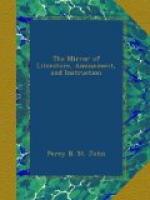We have marked many more extracts than we can insert, and find that we must content ourselves, and we hope the author, with again directing attention to his very interesting production.
[5] II. xi. v. 28.
[6] Also the oak, ilex,
chestnut, &c. though less abundant and
more
rare than on the leaves of the manna-ash. The
ordinary
manna
collected in Sicily, comes from districts in the Val
Demone
and the Val di Mazzara, at some distance from
the
localities
where this aerial manna fell.
* * * * *
NOTES OF A READER.
PICTURE OF VENICE.
(From Contarini Fleming, a Psychological Autobiography.)
An hour before sunset, I arrived at Fusina, and beheld, four or five miles out at sea, the towers and cupolas of Venice suffused with a rich golden light, and rising out of the bright blue waters. Not an exclamation escaped me. I felt like a man, who has achieved a great object. I was full of calm exultation, but the strange incident of the morning made me serious and pensive.
As our gondolas glided over the great Lagune, the excitement of the spectacle reanimated me. The buildings, that I had so fondly studied in books and pictures, rose up before me. I knew them all; I required no Cicerone. One by one, I caught the hooded Cupolas of St. Mark, the tall Campanile red in the sun, the Moresco Palace of the Doges, the deadly Bridge of Sighs, and the dark structure to which it leads. Here my gondola quitted the Lagune, and, turning up a small canal, and passing under a bridge which connected the quays, stopped at the steps of a palace.
I ascended a staircase of marble, I passed through a gallery crowded with statues, I was ushered into spacious apartments, the floors of which were marble, and the hangings satin. The ceilings were painted by Tintoretto and his scholars, and were full of Turkish trophies and triumphs over the Ottomite. The furniture was of the same rich material as the hangings, and the gilding, although of two hundred years’ duration, as bright and burnished, as the costly equipment of a modern palace. From my balcony of blinds, I looked upon the great Lagune. It was one of those glorious sunsets which render Venice, in spite of her degradation, still famous. The sky and sea vied in the brilliant multiplicity of their blended tints. The tall shadows of her Palladian churches flung themselves over the glowing and transparent wave out of which they sprang. The quays were crowded with joyous groups, and the black gondolas flitted, like sea serpents, over the red and rippling waters.




